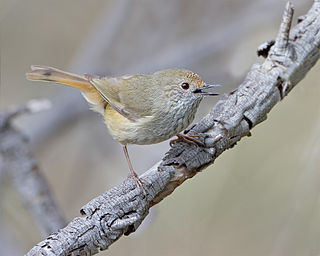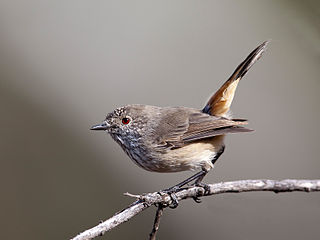
The striated pardalote is the least colourful and most common of the four pardalote species. Other common names include pickwick, wittachew and chip-chip. It is a very small, short-tailed bird that is more often heard than seen, foraging noisily for lerps and other small creatures in the treetops.

The yellow thornbill, formerly known as the little thornbill, is a tiny passerine bird endemic to the eastern coast of Australia. While currently listed as Least Concern by the IUCN, the general consensus is that the population is decreasing.

Acanthiza is a genus of passeriform birds, most endemic to Australia, but with two species restricted to New Guinea. These birds are commonly known as thornbills. They are not closely related to species in the hummingbird genera Chalcostigma and Ramphomicron, which are also called thornbills.

The brown thornbill is a passerine bird usually found in eastern and south-eastern Australia, including Tasmania. It can grow up to 10 cm (3.9 in) long, and feeds on insects. It is brown, grey and white. The species has five subspecies.

The yellow-rumped thornbill is a species of passerine bird from the genus Acanthiza. The genus was once placed in the family Pardalotidae but that family was split and it is now in the family Acanthizidae. There are four subspecies of yellow-rumped thornbill. It is a small, brownish bird with a distinctive yellow rump and thin dark bill. It inhabits savannah, scrub and forests across most of Australia and eats insects. The species engages in cooperative breeding.

The weebill is a species of bird in the family Acanthizidae. It is an insectivorous passerine that is found throughout mainland Australia. At 8 to 9 cm long, it is Australia's smallest bird. It was originally described by John Gould in 1838, and four subspecies are recognised. The weebill's plumage is nondescript, with olive-grey upperparts and paler, more yellowish underparts. It grades from more brownish plumage in the southern regions of Australia to more yellow in tropical areas.

The buff-rumped thornbill is a species of thornbill found in open forest land in eastern Australia, specifically from south of Chinchilla, Queensland and east of Cobar, New South Wales, across Victoria and southeastern South Australia, in an area of about 2,000,000 km2 (770,000 sq mi). The buff-rumped thornbill is found in temperate or subtropical/tropical moist environments living and feeding amidst the foliage or on the ground. However, they are known to prefer nesting sites one to two metres above ground level, particularly amongst the bark of trees. Of a similar size to other thornbills, 8–10 cm long, the buff-rumped thornbill is identifiable by its "buff-coloured rump and belly" and white irides in its eyes.

The slender-billed thornbill is a small bird native to Australia. It includes three sub-species:

The inland thornbill was originally described by English ornithologist John Gould in The Birds of Australia. Inland thornbills are within the order passerines. The inland thornbill belongs to the genus Acanthiza, which now has three more species than the eleven outlined by Gould in The Birds of Australia. The Noongar people of southwestern Western Australia call A. apicalis "Djoobi-Djoolbang". The inland thornbill is also known as the broad-tail thornbill and presently contains several subspecies that were once considered independent species. The word apicalis comes from the Latin for 'tipped'.

Tasmanian thornbill is a small bushland member of the Acanthizidae family, endemic to Tasmania and the Bass Strait Islands. It is a common bird in these regions and is often found occupying the colder, wetter portions of them. The brown thornbill will typically occupy the correspondingly drier portions of habitat.

The chestnut-rumped thornbill is a small passerine bird in the family Acanthizidae, endemic to Australia.

The rufous fieldwren also known as the desert wren or sandplain wren is a species of insectivorous bird in the family Acanthizidae, endemic to Australia.

The speckled warbler is a species of bird in the family Acanthizidae. It is endemic to eastern Australia. Its natural habitat is temperate forests.

The redthroat is a small, mostly ground-dwelling species of bird in the family Acanthizidae. It is endemic to Australia, occurring mostly in arid and semi-arid areas containing acacia and chenopod shrublands. The species has a distinctive red throat patch and is able to mimic the calls of numerous other bird species.

Acanthizidae—sometimes called Australian warblers—are a family of passerine birds which includes gerygones, thornbills Acanthiza, and scrubwrens Sericornis. The family Acanthizidae consists of small to medium passerine birds, with a total length varying between 8 and 19 centimetres. They have short rounded wings, slender bills, long legs, and a short tail. Most species have olive, grey, or brown plumage, although some have patches of a brighter yellow. The weebill is the smallest species of acanthizid, and the smallest Australian passerine; the largest is the pilotbird.

















